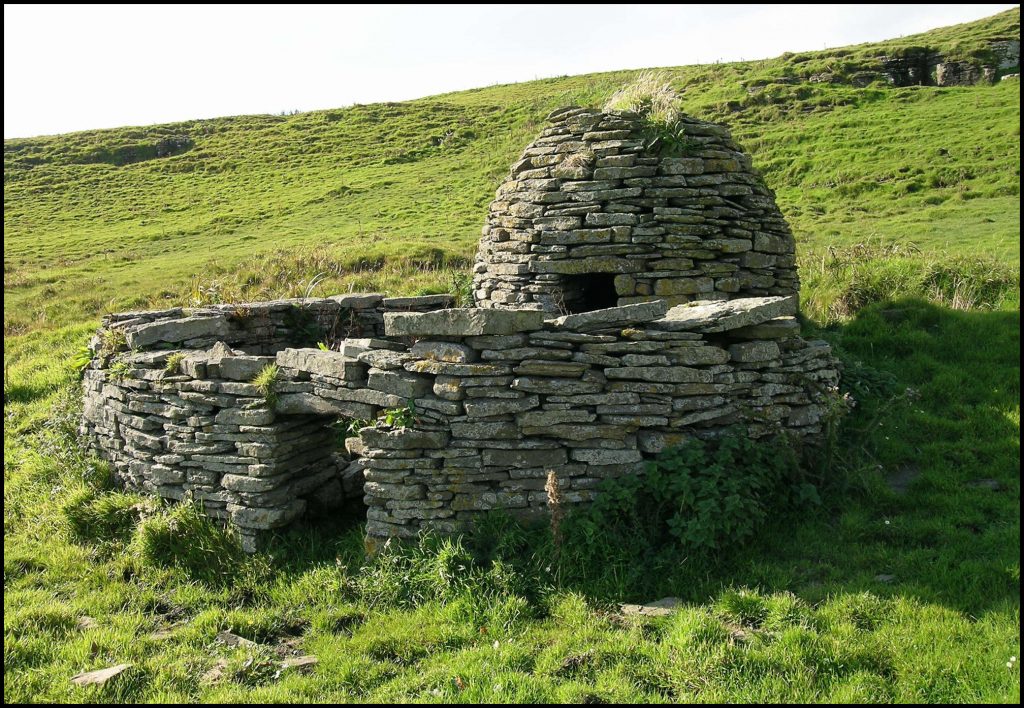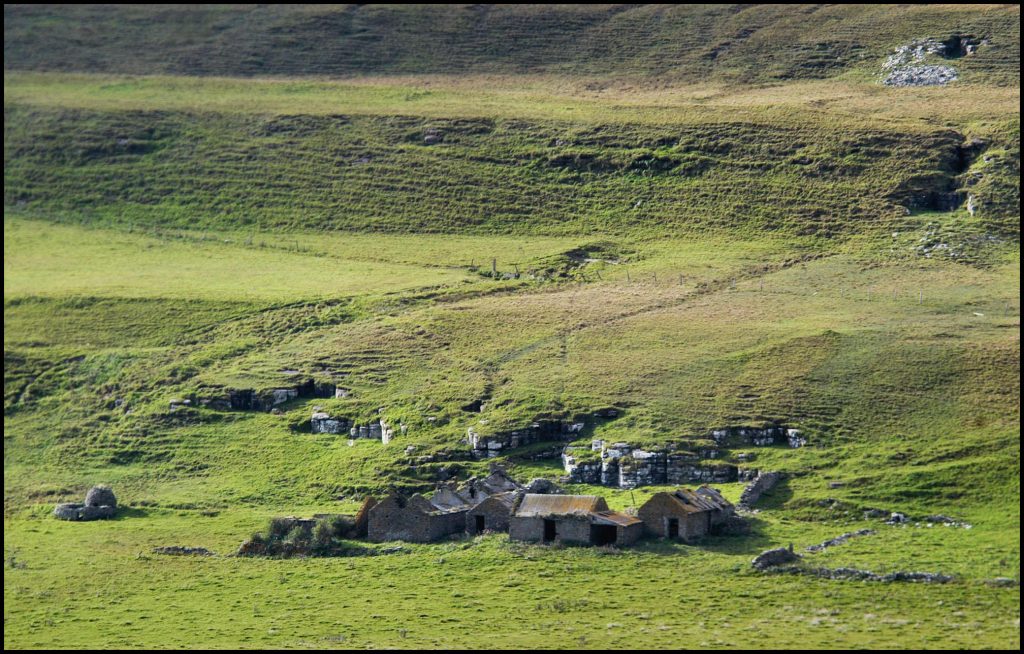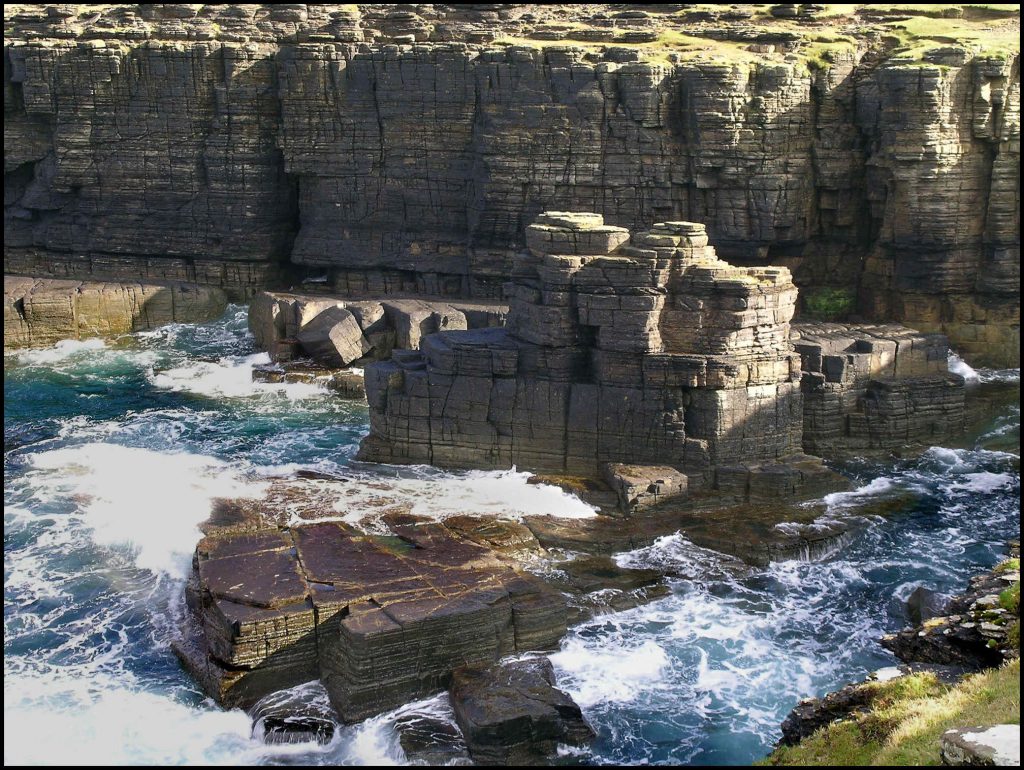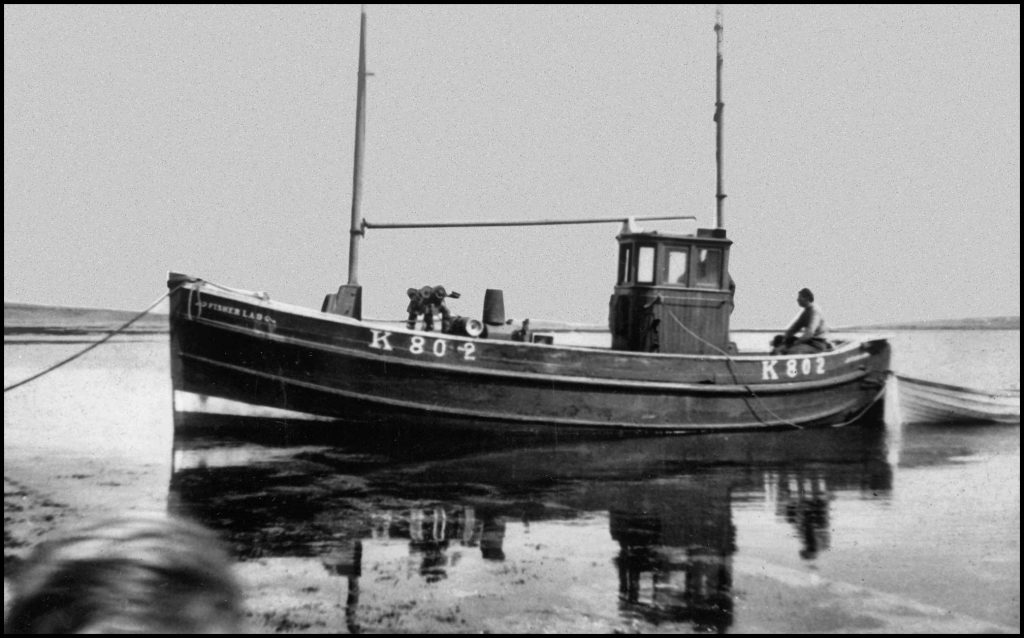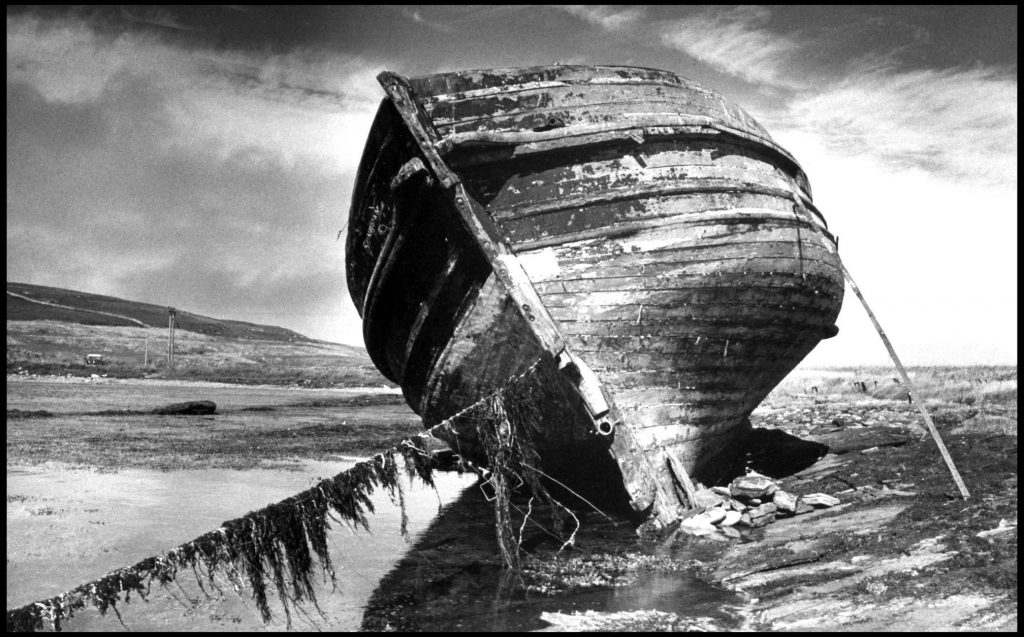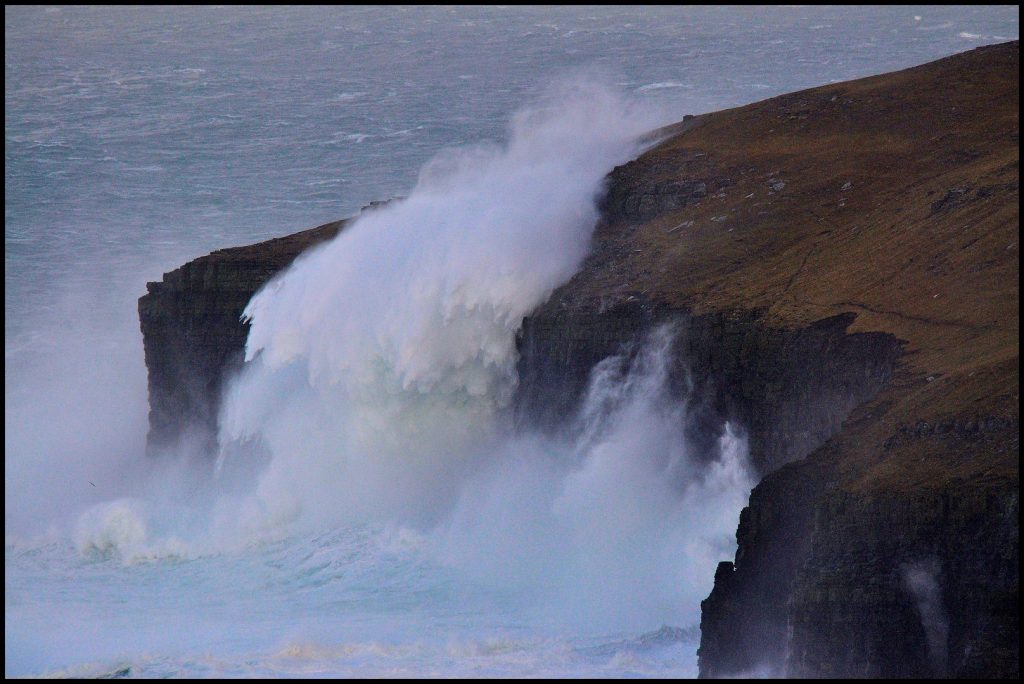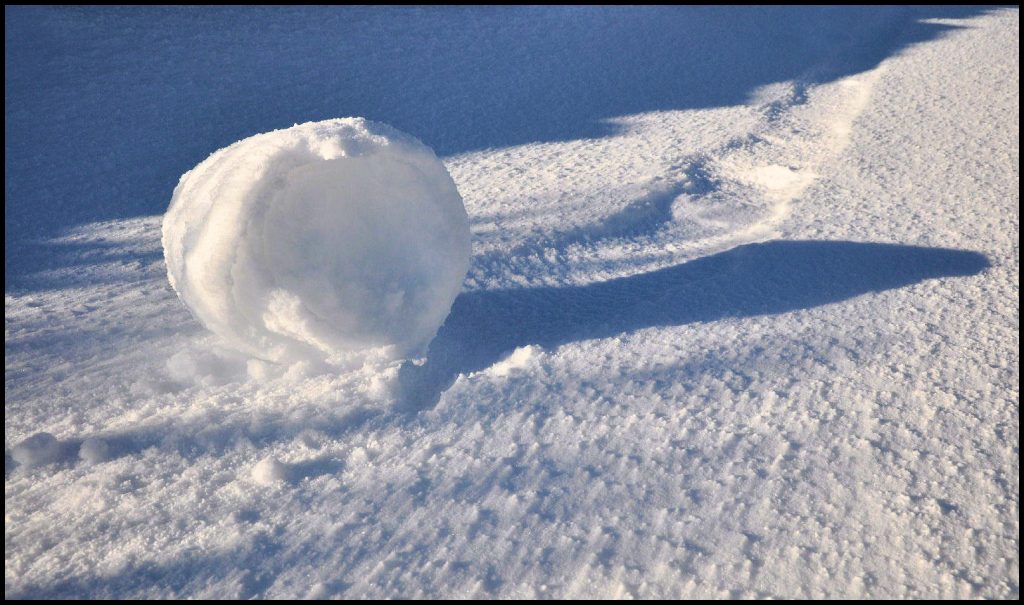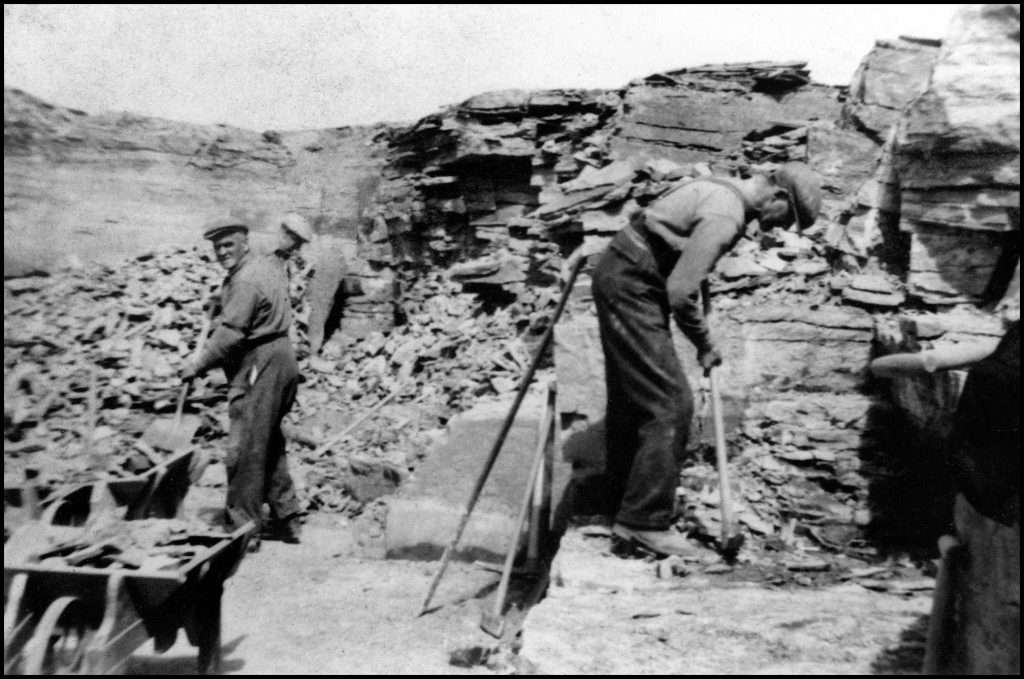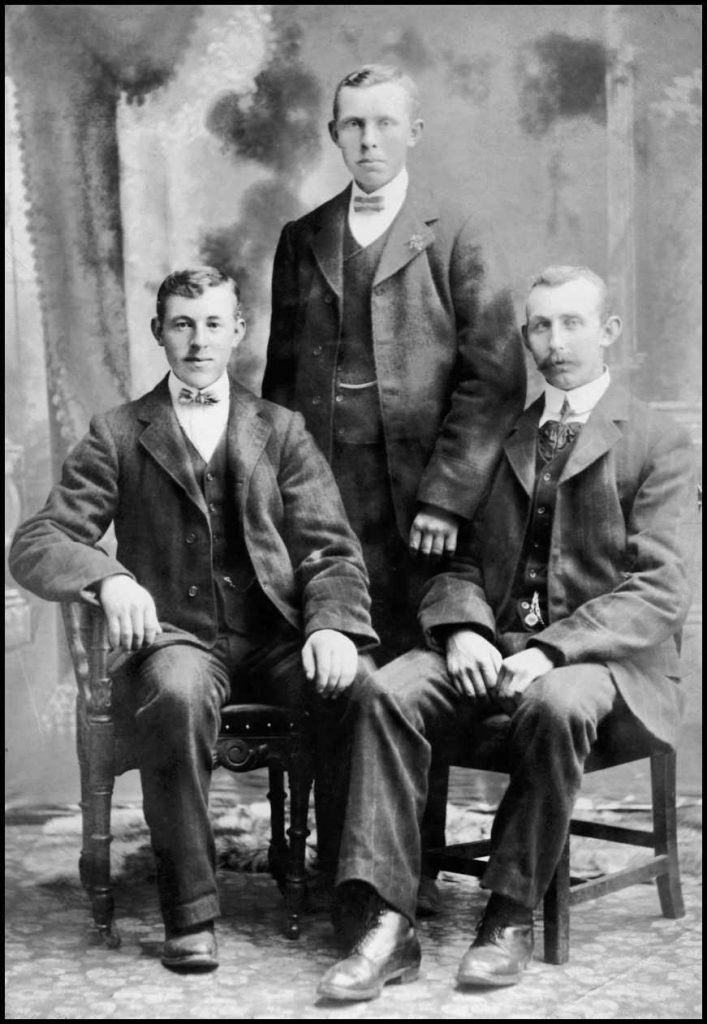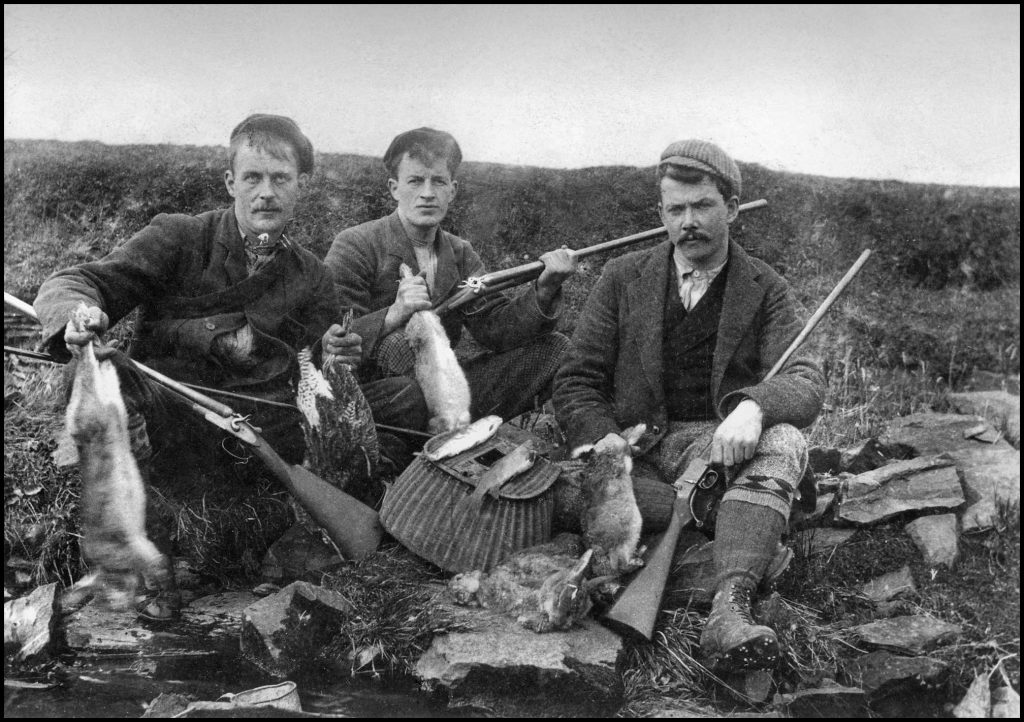The third of a four-part article
written by Tommy Gibson, Brinola, Rousay.
Blossan
At Swandale is a small round pigsty. This was built by William Harold, stonemason, from the Blossan. William was an excellent mason and built arches about the Blossan, now sadly all gone. I remember a small wheelbarrow house with an arched roof and in the house was a large arched fireplace. He also built the first part of the Leean dyke below the Blossan. The stones in this wall are small and must have taken a while to build. This dyke still stands and could be up to a hundred and forty-to-fifty years old. William also built or rebuilt Swartifield, plus a lot more in the vicinity.
Swandale
To the north of Swandale is a place called Garsnie Geo. It marks the boundary division between the farms of Swandale and Faraclett. A horse of Swandale was supposed to have jumped across the Geo about the middle. This would be an enormous leap. A body came ashore in WW2. This was found by Hugh Gibson, Bigland. Volunteers took a ladder and strapped the body and lifted it out. Another time Hugh was down in Garsnie Geo and around the corner a mine went off with a tremendous explosion. Just think about it, a mine exploding about 20-25 yards away. This must have been one of the worst experiences in his life. He was uninjured. Garsnie Geo was mostly passed by on the way to the fishing rocks of Lyber and Heshiber. Going down to Lyber was easy but Heshiber you had to use a rope to steady yourself. A long rope was usually kept at Swandale, and the fishermen called along to collect if they were going to Heshiber. There was a triangle on the top rocks and a knotted end of a rope was laid in this and a small stone was placed on top. With the aid of the rope fishermen went safely down the rock shelves to fish. To the west side of Garsnie Geo is the Blue Geos. This is high overhanging cliffs, and is one of the most dangerous places around the shore in Rousay. I know of two persons who went over and were killed. Many animals also went over here. The stable and midden of Swandale was said to be built on top of a chambered cairn. Long ago when empting the dung out of the midden the folk said that they could hear stones falling beneath them. I have never seen any record of such a mound at Swandale.
Fishing
One of the stories I heard about early fishing in Sourin was about fishing from top of the Knee of Faraclett. The men would make horse hair lines, attach a hook to the end and sit on the edge of the cliff with their legs dangle over. They would run the line over their boot down to water. A height of 90 to 100 feet of overhanging rock, this was said to be a excellent place for catching cod, and they say fish is cheap!
In Rousay’s past, fishing boats played a small part in its economy. Six large boats were hauled at the salt-water loch at Scockness every winter. The names are all but forgotten. I only know two. This was the Lively and the Rainbow. I know that a lot of stories are lost about the fishing. Some of the things I have heard, that it was cod was most abundant. Halibut was plentiful in the Sounds. In fact they used halibut to haul the boats upon. Another story of long ago, a huge whale was washed ashore at the North Sand at Scockness. It was said that the whale was that big it nearly filled the bay. The North Sand is about 110 yards wide at the bottom and tapers out to the top. If a large whale were lying halfway up there on the beach it would have looked massive. Along the Sourin shore there were five fish houses. This was used mainly for salting cod. The first one was below Breck. I can remember this house standing on the shoreline and where were four boat nousts alongside. There were two fish houses below Finyo on the land of Banks. The next house was below Gorehouse, and there is still a part of the foundations left. There was supposed to be another fish house below Cruar but there is not any evidence to where it was.
Willie Inkster, born Swartifield, told me a story about a duff and a boat. The story took place about 1885. James Johnston was a servant at Scockness and he was going out with an Alexander girl, a servant at Faraclett. This night the Learmonth family was having a muckle supper. Family, selected friends and neighbours were invited. The Stevenson’s of Scockness were invited but not JJ. Neither was Willie’s father, John Inkster who worked at Pow. This was next door. These two men along with others went to the cottage and took the plum duff out of the pot, (it was a large duff), ran down to the shore, pulled out to the Lively, and hid the duff in a bunk. They then went to Myres to Alan Gibson, who was sitting up with a mare who was having a foal. They went out to the stable with Alan checking the mare, saw lots of lights up at Faraclett. The folk were out looking for the duff, and they were extremely vocal when the duff was not found. The Lively went out the next day as usual, but the crew had a lovely tasty duff to eat. One of the reasons why this story has been kept and retold over and over, was probably, that not very much skull duggery took place, and when anything did happen it was well noted, told and retold.
There were usually two or three creel boats based in Ham in the fifties and sixties. The first boat I remember was the Fisher Lad. This boat came from Shetland, bought by William Mainland of Essaquoy. As well as creels, Bill also went to Kirkwall every Friday, taking some passengers and returning back in the late afternoon. A few dinghies were along the Sourin shore, and they were used for a few creels and going out for cauthes on a fine summer evening. Usually there were two in the soo boat. This was the old name for a dinghy in Rousay. The old fisherman never used the word dinghy, always a soo boat. When fishing cauthes one man sat in the starn (stern) and usually had two or three wands (this was always bamboo) and one man had to ando (row slowly) the boat. On the “wand” bought from the shop at a price of 2/6 in the fifties, and the line was sixpence. This strong green line was tied in the middle of the rod and half hitched to the end and tied so as not to twist. A set of three white feathered hooks was tied to the end of the line. They cost eightpence. This was the standard fishing equipment for many years. Cauthes and lythes were caught and dried and salted. I can remember when young, having fresh boiled cauthes with tatties and butter, and enjoying them, but could not now.
Wind and Weather
In the autumn of 1917 a severe thunderstorm was up in the side of Blotchnie Fiold. To say it was severe was an under-statement. It burst the sluice wall on the Muckle Water. Water that came down the Sourin burn was nearly at Woo. The Sourin Brig could not cope with such a volume of water. The water spread over the lands of Woo and Hurtiso, and nearly covered the Volspreet, and a lot drained down the Leean burn. There were drills of potatoes washed away at Lower Breck. At Lopness, the water was at the foundations of the house and water was in the mill, the miller was marooned in the house. Children from up the Sourin Brae, going to the school, could not even get to the cross roads. This was the largest amount of water ever to come down the Sourin burn. It must have been quite a sight, if someone was looking from, say Knapper, seeing all this flooding.
February 2nd 1952 a hurricane hit Britain with devastating results. The wind was in a north-westerly direction. Large amounts of fish, lobster, and crab etc. was washed up on the land of Scockness near the North Sand. This wind caused a lot of damage everywhere. That night the wind was that strong there were no waves on the sea due to the enormous pressure of the wind; a fine mist from the sea covered everything in salt. Damage was done to the school, the Kirk, the Comrades Hall was blown down, also dozens of henhouses. Hundreds of hens were killed. Dozens of stacks of crop were blown down and blown into the sea. The only good thing about the storm (not many good things can be said about the storm) was it took place at night. The amount of slates, sheet iron, felt, and a verity of every-day objects flying about did not cause any injury to anyone. I remember seeing a large turnip cut in two by a piece of roofing felt that was caught in the high winds.
In the winter of 1959 I remember the wind was in the north and with it came a night of snow. Nothing unusual about that, but the wind blew hundreds upon hundreds of large snowballs over the fields in Sourin. The wind caught and somehow rolled the soft snow along the ground and was gathered to a height, from about one foot to about three feet for the largest. By the afternoon a thaw had set in and everything was gone the next morning.
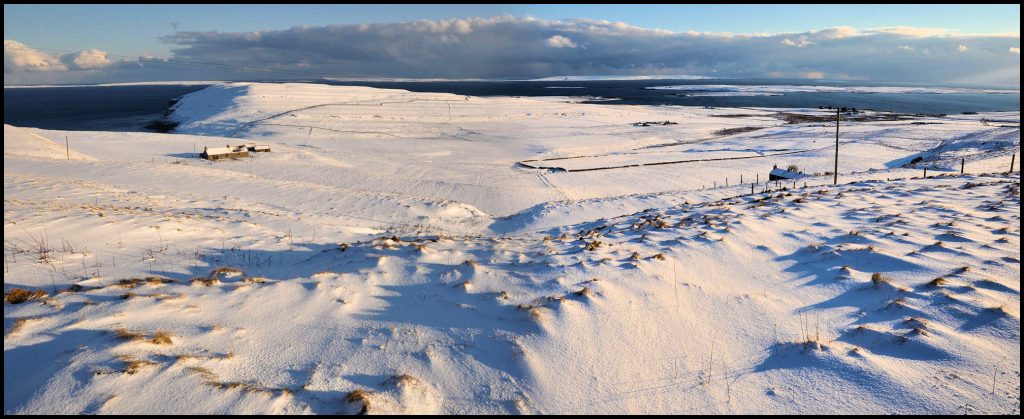
Dykes and Quarries
Sourin has its fair share of dykes but it is only the farms along the shore. Faraclett and Scockness, Banks, Glebe, and Avelshay have the lions share. There are hardly any dykes at Woo, Curquoy, Wasdale, Ervadale, Brendale, Broland, Bigland, Swandale, Hurtiso, Knarston, Myres and Essaquoy. Swandale has only one field dyked called Mugly. Most of the dykes in Rousay were built around 1860 to 1880. Good grants were available from the government for farming improvement. One day a Frotoft man was walking through Sourin going to Wasbister. Passing Hanover he came upon a woman gathering stones in her sekky brat (an apron made of coarse cloth). He greeted her, “whit err thoo duan?” he said, “Am biggan a byre for me coo”.
The man stopped and helped the woman and by the evening the byre was built and the man continued on his journey. Sourin like the other districts has a lot of small stone quarries. This was for stones for roads, houses, steadings and dykes. The quarries at the Blossan, Howdis (pronounced “Howdees) Knowe and near to the old community centre were road quarries. At Howdis Knowe the stones were quarried and broken down to road metal (stone chips). The roadmen were paid by the cube yard. Flag quarries were up the side of Kierfea, at Hunber, on the Head of Faraclett, and some were stones were quarried on a ridge to the south of Swandale. The stones that built the steadings of Hurtiso and Banks were quarried below the shore at Lopness. James Munro, mason, of Breval, built a dyke from Hurtiso along to the Leeng Burn in the late Twenties or the very early thirties.
The last dyke built in Sourin was the wall around the old Community Centre. The stones came from a quarry at the rear of Cruannie, this stone had good edges and was ideal for building. Berty Learmonth from Wyre and Magnus Wylie from the Blossan built the dyke in 1963-4. The last dyke built on agricultural land in Sourin for division and shelter was at Avelshay. This was 320m built for Sinclair Taylor. The mason was Graham Mathews from the Mainland.
A Sourin man was fencing on the lower reaches of Kierfea in the second war. Wooden strainers were scarce and he used a stone strainer. One was found up in the flag quarries near the top. He struggled and managed to get it down, dug a hole and secured the strainer. He then strained the wire, and tied it off. A warplane flew past, low down, near to the strainer, and it fell over! It was thought the noise broke the strainer. I can’t write what the farmer said.
Plane Crashes
On June 12th 1941 at 16.03hrs at the Blossan, a plane crashed near a small quarry between Digro and the Blossan. This was a Hurricane. Pilot Officer Reed from Bristol was in difficulties flying up the Sourin valley. He flew north over Swandale and then banked left, losing height, and crashed. The engine of the plane broke off and went tumbling down the braes and stopped quite near Fa’doon. A lot of debris and a lot of bullets were scattered around the site. All the neighbours quickly went to help, as there were not many vehicles about all the folk had to run up the hill. The Doctor was called. The plot was unconscious so he was laid on a door and carried to Digro. A nurse was sent out from Kirkwall to look after him. He lay in Digro for a few weeks then he recovered sufficiently to be transferred to hospital in Kirkwall where he made a complete recovery, the only effect was that he lost his memory. He could not remember being in the Air Force. The Home Guard was called out to mount an armed guard over the plane to stop theft.
On May 1st 1944 a Martinet from Twatt Aerodrome, Birsay, crashed-landed to the west of West Creay. Canadian pilot G.H. Abbott and L/ A TAG A.S. Boar were killed. They came in from the east over Bigland, the plane was on fire, and he was losing height. The plane crashed into a small green field on the side of the Brown Hill exploded on impact, a tremendous amount of smoke billowed forth. Both men were buried in the St. Ola kirkyard.
An aircraft crashed landed on the land of Avilshay, safely with no injury to the pilot. The pilot assessed the ground saying it was unsuitable for a take-off. The two fields of Trumland farm at the Lodge were chosen. The pilot then said that the fields were too short, and wanted to fill in the ditch between the fields. A boat was sent out from Kirkwall with a lot of men armed with spades and picks. The fence was taken down and these men tried to fill in the ditch. Local men who saw this were having a good laugh, most of the men had no idea how to work a spade and pick. The men eventually finished and the plane was manhandled to this long field. This meant taking down dykes and fences and building them up again. The pilot started up the engine and taxied, then took off in a very short space. The pilot wanted a few days leave. The fence was taken away and the two fields became one.
Wars
The first evidence of conflict is of one John Craigie who was wounded in the Battle of the Alma in the Crimean War in 1854; this was reported in the first page of the very first Orcadian newspaper. But perhaps before this is the Batteries on the Point of Avelshay. This is two small buildings, which both are still standing. The construction work of the buildings has been of a very high standard. This was perhaps built in the Napoleonic wars, around about 1814. Two cannons used to stand in recesses between the buildings. This was on hard core with large sturdy Rousay flagstones used for the floor. This was supposed to be fairly big guns, and they were pointed out towards the sound between Egilshay and Wyre. The emplacements were hidden from the sea, large quantities of earth were piled high and covered the two houses, the mound then tapered off to each side of the batteries. The cannons were gone by 1880. Inside the one house is still the timber rack, which held the muskets of the soldiers. General Burroughs of Trumland House was in charge of the territorials, and he had a cottage built for a sergeant, William Charlesworth. The name Bellona is after a God of War, and was built in 1877. A long dyke nearby was the shooting range of the territorials, this stretched from the public road at Bellona to nearly the shore. This was marked off in 100 yards, 200, and 300 yards. At one time, at certain target areas along the range, lead shot fell was gathered up and re-used. There is not a great deal of info about the but I have heard one story, a Wyre man was on parade with his comrades, somewhere on the land of Avelshay, was given a order, he refused, the officer said nothing, took the man’s rifle, smashed his face with the butt, then said, “next time you will answer me”.
Like the rest of the country the first and second wars had a big effect on everyone. There were over sixty men from Sourin involved in some way or another with the First World War. This must have caused a huge impact with everyone. Sons of families killed were John D. Grieve, age 18, Fa’doon; George Craigie, age 19, Pretty; John Inkster, age 18, Essaquoy; Edward Seatter, age 19, Banks; George Inkster, age 35, Knapper; Hugh Gibson, age 18, Oldman; David Munro, age 28, Old School; Graham Spark, age, 28, from the Established Manse. Eight killed in Sourin and many more injured, some were badly hurt. The young boys shed many tears when they left Rousay for the war. Some of them seemed to know that they would never see their home again. The second war, although serious, did not have the same impact as the first, nowhere near the same amount of men were called up for service. Like the first war watches was kept on the Head of Faraclett. A hut and telephone line again was installed. Thomas Walls from the Co-op House was killed. He was a clever young man of slight build, who was dux in the Kirkwall school. He joined the Royal Signals. At the fall of Singapore early in 1942 he was taken prisoner. He was subjected to harsh treatment by the Japanese army and he died shortly before the war ended.

Smith, Longhope; Cormack, Deerness; and John Harrold, Kirkwall,
who married Jeannie Harrold, Rose Cottage.
New Year
Long ago there was usually a holiday on New Year’s day. Then back to work for the second. In the 1880’s a lot of Sourin men went out shooting on New Year’s day. The Meadows of Swandale and down by Bigland to the meadows of Hurtiso was popular for snipe. Alan Gibson of Myres later Bigland, and some of his pals were walking up through Cuppo discussing this and that. They then wondered if their guns could be held up by their trigger. Alan then took his gun and tried this. Unfortunately the gun went off with one unholy bang and blew a substantial hole in the ground between his feet. He was very lucky that his feet were not close together. That put a stop to any more “fools” wark.
Some Sourin boys went first-footing, visiting the folk at Breck one New Year, about 100 and something years ago. They knocked on the door, the old man arose from his bed, welcomed the boys in. He tended to their needs and insisted to give them shortbread. The shortbread was in the bottom of the girnel. The old man was bent well over trying to retrieve the bread, and his nightshirt rose up and revealed a bare bum. He, by this time, was stuck. The boys, instead of helping him, took the water bucket and sloshed his rear end, then ran. So much for kindness!
All black and white photos are courtesy of the author, Tommy Gibson.
